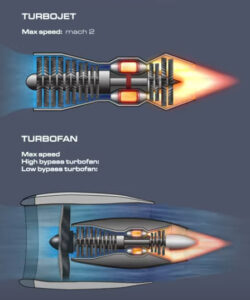
To meet changing demands, jet engine design has evolved over the decades. Two types centre to this progress are the turbojet and turbofan. In this post, I will discuss the differences between these jet engines, and what the future holds for them.

The turbojet – the original jet engine
I covered the basics of jet engines and the turbojet in a previous post: Fastest Jet Engines – Animated Schematic.
To give you a quick recap:
- Jet engines use combustion to provide thrust. Combustion occurs when fuel reacts with oxygen.
- Turbojets draw in oxygen from the atmosphere to run. A compressor squeezes the oxygen to high pressures to allow for efficient combustion.
- When the oxygen reacts with fuel in the turbojet burners, a rapid expansion of gases flows out the back of the engine for forward thrust. These gases also drive a turbine which power the upstream compressor.
Turbojets have zero bypass air. This means all the air passing through the engine contributes to the combustion.
The turbojet is the original jet engine. It produces huge amounts of thrust, driving aircraft to supersonic speeds. Without afterburners, turbojet aircraft like the Concorde can achieve speeds of up to around mach 2 (two times the speed of sound).
For other reasons, though, the turbojet has fallen out of favour with modern aircraft design.
The turbofan and its advantages
The turbofan is a jet engine design that first appeared in the 1940s, about a decade after the turbojet. It’s like the turbojet, but with the key addition of bypass air. This bypass air is a portion of air that contributes to thrust without passing through the engine core and being combusted.
The bypass air is driven by a large fan at the inlet of the engine. Hence the name ‘turbofan’’. Like with the compressor, the downstream turbine powers the fan.
Running along the outside of the engine core, the bypass air cools the engine before being ejected out the back to add to the forward thrust.
While not as fast as the turbojet, the turbofan is more efficient and quieter because of the bypass air. Modern airliners use the turbofan for this reason and for the longer range they can achieve. Even fighter jets today employ turbofan engines instead of turbojets.
Turbofan bypass ratio
The amount of bypass air a turbofan uses plays a large part in its performance. Hence why the bypass ratio (BPR) is an important measure in turbofan design.
BPR is found by dividing the mass flow rate of the bypass air by the mass flow rate of the core air. For example, an engine drawing in 100kg/s for the bypass air and 20kg/s for the core air has a BPR of 100 / 20 = 5.
Turbofans are typically categorised as high bypass or low bypass. Modern airliner engines are high bypass, with BPR figures of often 10 or higher. High bypass engines are only capable of speeds less than mach 1.
Today’s fighter jet turbofan engines are low bypass with BPR figures often under 1. These, like the ones used on the F22 Raptor, are capable of speeds of up to about mach 1.5 without the use of afterburners.
How the bypass ratio affects efficiency
The higher the bypass ratio of a turbofan engine, the higher the efficiency. To explain why, let’s look at the equation:
η = 2 / (1 + (ve / v))
Where,
- η is the propulsive efficiency of the engine
- ve is the exhaust velocity
- v is the velocity of the aircraft
As you can see from above, lowering the exhaust velocity (ve) while keeping the aircraft velocity constant (v), raises the efficiency (η).
And how do we lower the exhaust velocity? By increasing the BPR. By having larger amounts of bypass air, we are exchanging some exhaust velocity for more exhaust volume.
For this reason, airliners have a large BPR figures to maximise efficiency. While fighter jets have small BPR figures to trade in less speed with some efficiency benefit.
The future of the turbojet and turbofan
Today, turbojets are over-shadowed by turbofans, and this will continue.
Engine makers are developing next gen turbofans with super high bypass ratios. The Rolls-Royce UltraFan will have a BPR value near 15 to push the upper limits of efficiency. To make this possible, the Ultrafan employs a gearbox to increase fan torque, along with variable pitch fan blades.
Turbojet engines, on the other hand, are now limited to niche applications and cruise missiles. The SR-72 Darkstar, a hypersonic UAV currently in development, is one exciting project using turbojets. However, the amazing speed of the SR-72 will be because of scramjets – the turbojets will only take off and lower speed flight will use the turbojets.